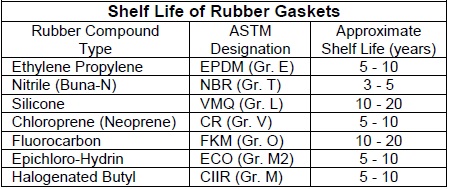GASKET STORAGE & SHELF LIFE
Most rubber compound gaskets will undergo changes as they age during storage. The physical properties can degrade making the gasket unusable due to excessive hardening, softening, cracking, crazing, and or other surface degradations. The cause of gasket degradation can be the result of one or a combination of factors including; oxygen, ozone, light, heat, humidity, oils, water, or other solvents and acids including vapors. The degrading effects of these factors can be minimized by following proper storage procedures and conditions.
Shelf Life
In normal warehousing conditions, the shelf life of age-sensitive rubber gaskets is considerable; due in large part to improvements in today’s compounding techniques. Table 1 (below) lists the general recommended shelf life limitation for the most widely used gasket compounds. The estimates in this table are conservative.
Table 1

The following guidelines will help ensure longer shelf life for your rubber gaskets.
Temperature
The optimum storage temperature should range between 40oF (5oC) and 80oF (25oC). Higher temperatures do accelerate the deterioration of rubber gaskets, so sources of heat in storage temperatures should be controlled so as not to exceed 80oF (25oC).
Exposure to temperatures below freezing 32oF (0oC) may not permanently damage the rubber. However, it should be noted that rubber stiffens at low temperature. Care should be taken when handling and installing cold rubber. If stored in cold conditions the cold gaskets should be allowed to warm to room temperature conditions before being installed or commissioned in use. Storage of gaskets in freezing conditions is not recommended.
Humidity
The relative humidity in your storage area should be below 75%. Very moist or very dry conditions should be avoided. Condensation should not be allowed to occur.
Light
Rubber gaskets should be protected from light, in particular sunlight and strong artificial light with a high ultraviolet content. The storing of gaskets in polyethylene bags within cardboard containers and polyethylene-lined craft bags offer good protection against light.
Oxygen and Ozone
Oxygen (O2) and Ozone (O3) are very damaging to rubber products, thus whenever possible, gasket should be stored in airtight containers to protect them from circulating air. Ozone is particularly damaging, and causes “scission” of the carbon backbone polymer chain into smaller chains. Rubber gaskets should be kept away from ozone- generating equipment, such as electric motors, mercury vapor lamps, and high voltage electrical equipment.
Deformation
Rubber gaskets should be stored in their original packages until mounted. This will avoid size and grade mix-ups while simultaneously protecting the gaskets from external elongation, compression or other types of deformation that can lead to cracking or permanent change of shape
Important
To ensure proper performance and a long service life do not store gaskets or gasketed components outside where they would be exposed to elements including sunlight, dust and inclement weather. Components that have been stored outside should have their gaskets replaced before installing into a piping system.
If you have questions about the shelf life or storage conditions of rubber gaskets, please contact Shurjoint.